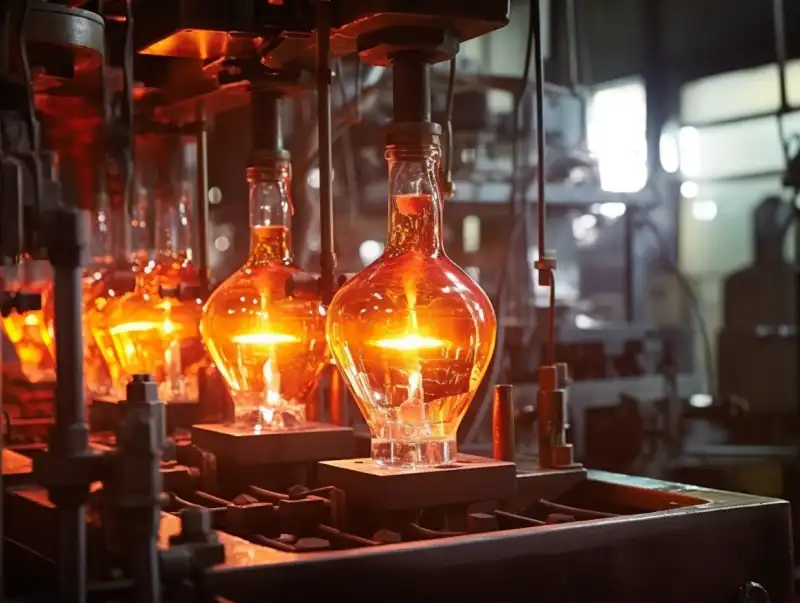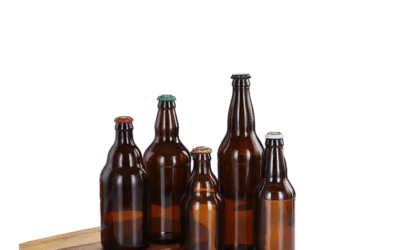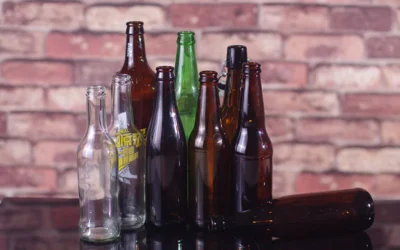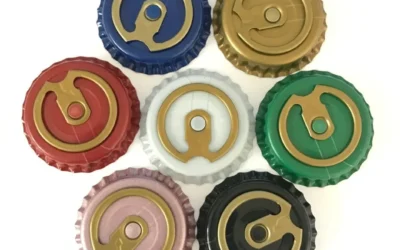1 – Raw Materials for Glass Bottle Manufacturers
Most of the raw materials used to make glass bottles are sand, soda ash and limestone. Crushed glass is added to this mixture. Crushed glass is broken glass, either as waste from the manufacturing process or from recycling centres, saving 1,300 lbs. of sand, 410 lbs. of soda ash and 380 lbs. of limestone for every ton of glass recycled. This saves on manufacturing costs, cost and energy savings and allows customers to get an economical price on our products.
2 – Melting of raw glass bottles in a furnace
The raw materials and broken glass are continuously melted at high temperatures, around 1650°C. The furnace operates 24 hours a day and the raw material mixture is formed into molten glass in about 24 hours. The molten glass passes through
The molten glass passes through a forehearth and then at the end of the forehearth the glass stream is cut into pieces according to weight at a precisely set temperature.
3 – Glass bottle/jar moulding
Two moulding methods are applicable: pressure-blowing or blow-blowing, performed in IS machines.
Press-blown glass bottles
The cut droplets are dropped and pressed into a blank mould with a metal plunger, where it expects the shape of the mould and is then called a parison. Next, the parison is moved into the final mould and blown into the mould for final measurement. This process is typically used for wide-mouth glass bottles, but can also be used to produce thin-necked glass bottles.

Blown Glass Bottles
The cut droplets fall and in blow blow moulding, the droplets are compressed into a blank mould and compressed air is used to push the droplets into place, called a parison, to move to the final mould to be blown again to form the inside of the framed glass bottle. Glass bottles with different neck thicknesses (narrow containers) can be manufactured using the blow blow arrangement.
4-Annealing in the glass bottle manufacturing process
Regardless of the process, blown glass containers are usually given a surface coating after they have been moulded.
While they are still hot, to make the bottles and jars more resistant to scratching, this is known as the hot end surface treatment, and the glass bottles are then taken to an annealing furnace, where their temperature is restored to approximately 815 °C, and then lowered progressively to below 480 °C. This will take approximately 4 hours. This will take about 2 hours. This reheating and slow cooling removes the pressure from the container. This enhances the robustness of naturally occurring glass containers. Otherwise, the glass will break easily.
5 – Quality Inspection of Glass Bottles
Prior to inspection, they are usually treated with a cold-end surface coating that reduces the temperature of the glass container to about 100°C, otherwise the glass scratches easily.
After leaving the cold end of the annealing furnace, to ensure product quality, we use Led Beam Technology (Led Inspection), Camara Inspection Machines, and Integrated Inspection Machines to detect faults not visible to the naked eye. These include, but are not limited to: closure surface inspection, dimensional analysis, wall thickness inspection, breakage detection, edge and bottom scanning, and wall scanning. Any bottles that do not meet the standards will be automatically rejected and these rejected bottles will be re-melted and re-used as raw material. Automatic inspection will ensure consistent quality for our customers.

6 – Glass bottle packaging
The way in which the glass bottles are packaged will depend on the customer’s requirements. Usually we use the following two methods of packaging.
Standard palletised packaging (Bulk Pack)

Carton Tray Pack (Case Pack)



